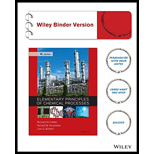
A liquid-phase chemical reaction with stoichiometry A ? B takes place in a semibatch reactor. The rate of consumption of A per unit volume of the reactor contents is given by the first-order rate expression (see Problem 10.19)
where CA(mol A/L) is the reactant concentration. The tank is initially empty. Beginning at a time t = 0, a solution containing A at a concentration CA0(mol A/L) is fed to the tank at a constant rate
Write a differential balance on the total mass of the reactor contents. Assuming that the density of the contents always equals that of the feed stream, convert the balance into an equation for dV/dt, where V is the total volume of the contents, and provide an initial condition. Then write a differential mole balance on the reactant. A, letting NA(t) equal the total moles of A in the vessel, and provide an initial condition. Your equations should contain only the variables (VA, V, and t and the constants
- and CA0. (You should be able to eliminate CAas a variable.)
- Without attempting to integrate the equations, derive a formula for the steady-state value of NA.
Want to see the full answer?
Check out a sample textbook solution
Chapter 10 Solutions
Elementary Principles of Chemical Processes 4e Binder Ready Version + WileyPLUS Registration Card (Wiley Plus Products)
Additional Engineering Textbook Solutions
Elementary Surveying: An Introduction To Geomatics (15th Edition)
Thinking Like an Engineer: An Active Learning Approach (4th Edition)
Starting Out With Visual Basic (8th Edition)
Electric Circuits. (11th Edition)
Starting Out with Python (4th Edition)
Java: An Introduction to Problem Solving and Programming (8th Edition)
 ChemistryChemistryISBN:9781305957404Author:Steven S. Zumdahl, Susan A. Zumdahl, Donald J. DeCostePublisher:Cengage Learning
ChemistryChemistryISBN:9781305957404Author:Steven S. Zumdahl, Susan A. Zumdahl, Donald J. DeCostePublisher:Cengage Learning ChemistryChemistryISBN:9781259911156Author:Raymond Chang Dr., Jason Overby ProfessorPublisher:McGraw-Hill Education
ChemistryChemistryISBN:9781259911156Author:Raymond Chang Dr., Jason Overby ProfessorPublisher:McGraw-Hill Education Principles of Instrumental AnalysisChemistryISBN:9781305577213Author:Douglas A. Skoog, F. James Holler, Stanley R. CrouchPublisher:Cengage Learning
Principles of Instrumental AnalysisChemistryISBN:9781305577213Author:Douglas A. Skoog, F. James Holler, Stanley R. CrouchPublisher:Cengage Learning Organic ChemistryChemistryISBN:9780078021558Author:Janice Gorzynski Smith Dr.Publisher:McGraw-Hill Education
Organic ChemistryChemistryISBN:9780078021558Author:Janice Gorzynski Smith Dr.Publisher:McGraw-Hill Education Chemistry: Principles and ReactionsChemistryISBN:9781305079373Author:William L. Masterton, Cecile N. HurleyPublisher:Cengage Learning
Chemistry: Principles and ReactionsChemistryISBN:9781305079373Author:William L. Masterton, Cecile N. HurleyPublisher:Cengage Learning Elementary Principles of Chemical Processes, Bind...ChemistryISBN:9781118431221Author:Richard M. Felder, Ronald W. Rousseau, Lisa G. BullardPublisher:WILEY
Elementary Principles of Chemical Processes, Bind...ChemistryISBN:9781118431221Author:Richard M. Felder, Ronald W. Rousseau, Lisa G. BullardPublisher:WILEY





